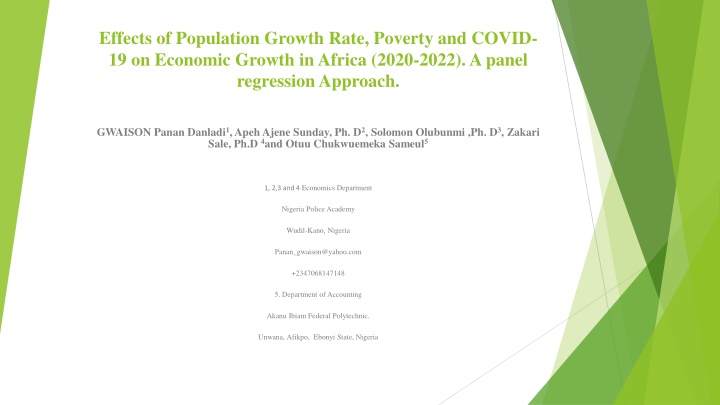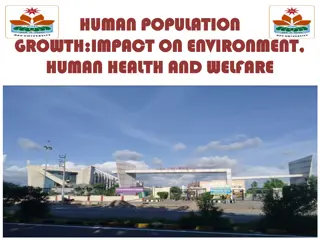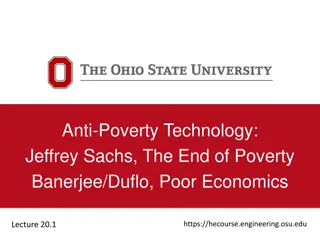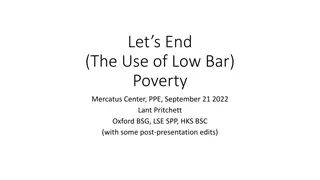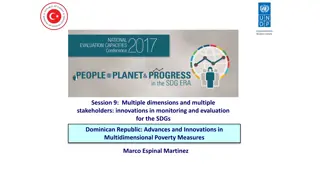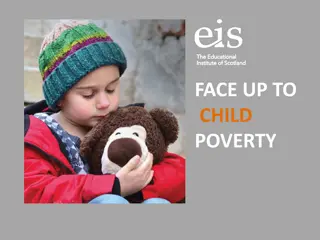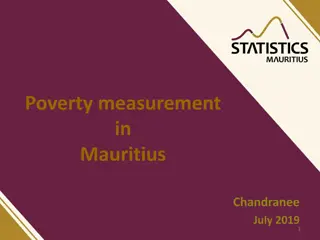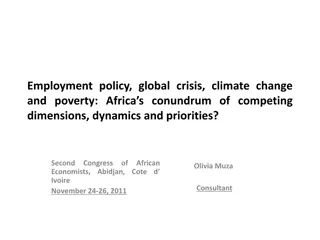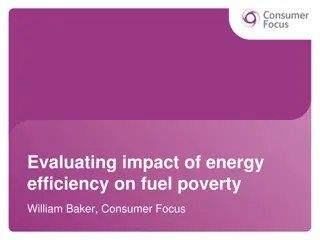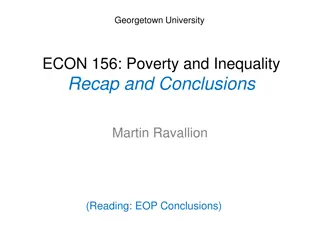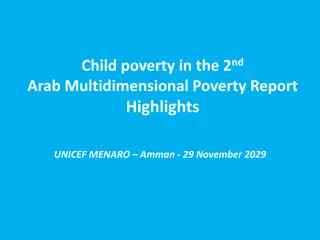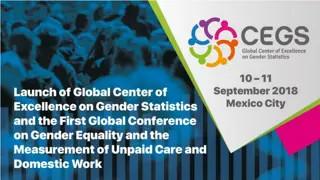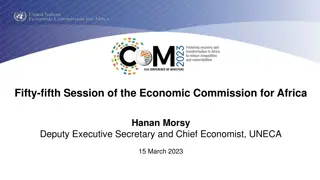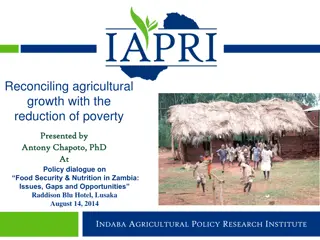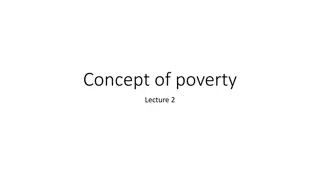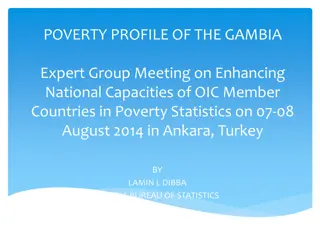Effects of Population Growth, Poverty, and COVID-19 on Economic Growth in Africa (2020-2022)
This study delves into the intricate relations between population growth, poverty, and the COVID-19 pandemic on economic growth in Africa from 2020 to 2022. It examines the impact of these factors through a panel regression approach, aiming to unravel their combined effects in the continent's socio-economic landscape.
Download Presentation

Please find below an Image/Link to download the presentation.
The content on the website is provided AS IS for your information and personal use only. It may not be sold, licensed, or shared on other websites without obtaining consent from the author.If you encounter any issues during the download, it is possible that the publisher has removed the file from their server.
You are allowed to download the files provided on this website for personal or commercial use, subject to the condition that they are used lawfully. All files are the property of their respective owners.
The content on the website is provided AS IS for your information and personal use only. It may not be sold, licensed, or shared on other websites without obtaining consent from the author.
E N D
Presentation Transcript
Effects of Population Growth Rate, Poverty and COVID- 19 on Economic Growth in Africa (2020-2022). A panel regression Approach. GWAISON Panan Danladi1, Apeh Ajene Sunday, Ph. D2, Solomon Olubunmi ,Ph. D3, Zakari Sale, Ph.D4and Otuu Chukwuemeka Sameul5 1, 2,3 and 4 Economics Department Nigeria Police Academy Wudil-Kano, Nigeria Panan_gwaison@yahoo.com +2347068147148 5. Department of Accounting Akanu Ibiam Federal Polytechnic. Unwana, Afikpo, Ebonyi State, Nigeria
Introduction Africa, a continent marked by its rich cultural diversity and vast natural resources, stands at a critical juncture in its socio-economic trajectory. As the second most populous continent, Africa's demographic landscape is characterized by a rapidly growing population. The population growth rate in Africa has been a subject of considerable scholarly and policy discourse. Over the past few decades, the continent has experienced significant demographic changes, with projections indicating that its population will continue to rise substantially in the coming years. Poverty, a longstanding issue in many African nations, adds another layer of complexity to the economic landscape.
Introduction Count. In the backdrop of these challenges, the emergence of the COVID-19 pandemic has cast a long shadow over Africa's economic prospects. The continent's vulnerability to health crises is magnified by pre-existing economic and social disparities. The pandemic has not only strained healthcare systems but has also triggered disruptions in global supply chains, impacting trade, investment, and employment elements crucial to sustained economic growth This study aims to unravel the intricate web of relationships between population growth rate, poverty, and the COVID-19 pandemic, and their combined impact on economic growth in Africa.
Objectives of the Study The aim of this study is to examined the effects of population growth rate, poverty and COVID-19 on economic growth in Africa raging from 2020-2022. Specifically, the study seeks to; i. Find out the impact of population growth rate on economic growth inAfrica ii. Examine the impact of poverty on economic growth inAfrica iii. Ascertain the impact of COVID-19 on economic growth in Africa
Hypothesis of the Study The following null hypothesis were tested at 0.05 level of significance Population growth rate has no significant impact on economic growth inAfrica i. ii. Poverty has no significant impact on economic growth inAfrica iii. COVID-19 has no significant impact on economic growth inAfrica
Literature Review The Study review 5 theories Demographic Dividend Theory by Warren Thompson and Frank Notestein in Mid-20th century. Dependency Theory by Ra l Prebisch and Hans Singer(1950s-1960s) Demographic Transition Theoryby Warren Thompson and Frank Notestein in Mid-20th century. Malthusian Theory by Thomas Malthus in Late 18th century Structural Transformation Theory byW. Arthur Lewis and Rostow (1950s-1960s ). Inclusive Growth Theory by Joseph Stiglitz et al in Late 20th century Review of Empirical Studies Asare and Barfi (2021) , Zhu, Bashir, and Marie (2022), Mahtta et al. (2022), Gagnon, Kamin, and Kearns (2023) and Zineb, Zineb, and Ikram (2022)
Methodology This study used ex post facto research design. Ex post facto research design, also known as causal-comparative research design, is a type of research design where the researcher examines the effects of an independent variable that cannot be manipulated for ethical or practical reasons. This study used secondary data, the data were sourced from world development indicators website. The study covered from 2020-2022 in 36 African countries The Panel regression technique was used to analyse the data. Both pre-test and post test were conducted with the aids of E-view-10. The general form of a panel regression model is as follows: RGDPit = 0 + 1PGRit + 2POVRit + 3CNDit +uit + i + it The apirori expectations 1 , 2 , and 3<0
Result Presentations Variables RGDP PGR POVR CND Mean 4.89E+10 2.269741 6.94E+10 150834.0 Median 1.51E+10 2.400000 2.26E+10 32609.00 Maximum 4.77E+11 3.700000 1.06E+12 4048580. Minimum 1.23E+09 -0.300000 0.000000 509.0000 Std. Dev. 9.55E+10 0.780755 1.52E+11 515625.6 Skewness 3.366018 -0.905366 4.493270 6.549927 Kurtosis 13.70751 3.992115 25.40088 46.63445 Jarque-Bera 1.18702 1.18368 2.62507 1.934070 Probability 0.734510 0.823671 0.98219 0.19820 Sum 5.29E+12 245.1320 7.49E+12 16290067 Sum Sq. Dev. 9.76E+23 65.22482 2.47E+24 2.84E+13 Observations 108 108 108 108
Table 2. Correlation matrix for the variable Covariance Correlation RGDP PGR POVERTY CND RGDP 9.04E+21 1.000000 PGR -6.39E+09 0.603933 -0.086490 1.000000 POVR 1.20E+22 -5.62E+09 2.29E+22 -0.333682 -0.047804 1.000000 CND 3.03E+16 -117373.0 3.70E+16 2.63E+11 -0.221233 -0.294279 0.476301 1.000000
Table-4 : Kao Residual Cointegration Test t-Statistic Prob. ADF -8.649178 0.0000 Residual variance 6.498177 HAC variance 4.988797
Table 6. Fixed Effect Result Variable Coefficient Std. Error t-Statistic Prob. C 7.53E+10 2.02E+10 3.737743 0.0004 PGR -1.21E+10 8.78E+09 -1.382506 0.1713 POVR -0.037289 0.007277 -5.124147 0.0000 CND -2.478028 2919.539 -8.487739 0.0000 Effects Specification Cross-section fixed (dummy variables) R-squared 0.997550 Mean dependent var 4.89E+10 Adjusted R-squared 0.996200 S.D. dependent var 9.55E+10 S.E. of regression 5.89E+09 Akaike info criterion 48.10473 Sum squared resid 2.39E+21 Schwarz criterion 49.07327 Log likelihood -2558.655 Hannan-Quinn criter. 48.49744 F-statistic 739.1924 Durbin-Watson stat 2.294417 Prob(F-statistic) 0.000000
Table 3: LLC Unit Root Test Variables Statistics P-Value Order of Integration RGDP -37.2126 0.0000 1(0) PGR -30.4613 0.0000 1(0) POVR -22.4264 0.0000 1(0) CND -2.01913 0.0113 1(0)
Conclusion The findings of this study underscore the detrimental effects of both poverty and the COVID-19 pandemic on economic growth in Africa. The negative and significant impact observed highlights the urgent need for targeted and comprehensive interventions to address these challenges. Moreover, while the population growth rate was found to have a negative impact on economic growth, the insignificance of this effect suggests that other factors might be more influential in shaping the economic landscape. In conclusion, a multifaceted and coordinated approach is necessary to overcome the negative impacts of poverty, the COVID-19 pandemic, and demographic factors on economic growth in Africa.
Recommendations Implement and strengthen poverty alleviation programs that address the root causes of poverty, such as lack of access to education, healthcare, and employment opportunities. These programs should be designed to promote inclusive growth and empower vulnerable populations. Enhance healthcare infrastructure and invest in pandemic preparedness to mitigate the impact of future health crises. Strengthening healthcare systems, ensuring equitable access to vaccines, and promoting public health measures are essential components of a resilient response. Encourage economic diversification to reduce dependence on specific sectors and enhance overall economic resilience. Diversification can create new opportunities for growth and help countries navigate external shocks more effectively. Prioritize education and skill development initiatives to enhance human capital. A well-educated and skilled workforce is crucial for innovation, productivity, and overall economic development.
